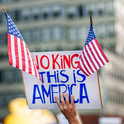Rahaf Mohammed al-Qunun's story shows the internet can also do good. Photo: YouTube screengrab
Here’s a thought. What if in 2019, 30 years since the invention of the World Wide Web, we all resolve to do more to harness its power for good, rather than feed off and focus on its dark side?
Increasingly, users—and governments—view the internet as a place of danger from which we have to be protected: a den of gangsters, a haven for trolls, a world full of risk and danger. (The fact that the UK government is now calling its internet safety strategy “Online Harms” is a case in point).
While it is true that the internet, and social media
The story this week of Saudi teenager Saudi teenager Rahaf Mohammed al-Qunun, who tweeted her demands for asylum after barricading herself in a Bangkok airport hotel room, is a case in point.
"I wish you had
taken her phone"
The plight of the 18-year-old, who argued she faced death if she returned to Saudi Arabia, was picked up in real-time by prominent activists like Mona Eltahawy and quickly escalated into a global public online furore that forced governments and UN agencies into action.
The comments of a Saudi official who flew to Thailand to deal with the case are telling. “I wish you had taken her phone, it would have been better than (taking) her passport,” he told Thai officials.
Changing hearts and minds
Platforms like Twitter can unleash mass pile-ons that result in vile abuse being directed at individuals, or those seen as belonging to a particular group.
But that same mechanism is what helps appeals for help or support spread at lightning speed and offer vital solidarity and positive action. It is what has helped sustain and spread movements like #MeToo or Zimbabwe’s #ThisFlag movement, giving courage to those who previously felt isolated and alone.
And while we are quick to decry social media as too much of an echo chamber, it can change minds too.
Megan Phelps-Roper, whose family founded the controversial US Westboro Baptist Church that openly condemns homosexuality and people of other faiths, credits Twitter with helping her to leave the controversial religious group.
It was Twitter where she was first exposed to viewpoints that clashed with her own—and people who were willing to question her on them. She has since left the church and is a now passionate advocate for social media as a platform for conversation and change.
Changing hearts and minds is not easy. It is made complicated by anonymity: a vital tool to protect people so they can talk about their personal experiences without fear of retribution, but which also allows people to taunt, harass and abuse with little apparent comeback.
Abolishing anonymity might restrain people from saying things they would otherwise shy away from in real life, but the damage this would do to those who rely on anonymity to report abuse, challenge authoritarian governments, or whistleblow on corrupt employers far outweighs such purported benefit.
Good vs bad speech?
Nor is it a solution to think we can simply ban the ‘bad’ speech. While we think it’s easy to distinguish one from the other so that only ‘the good’ is promoted, it’s not always so straightforward in practice.
Take the case of Twitter CEO Jack Dorsey who caused outrage when he posed with a poster reading “smash Brahminical patriarchy.” While some denounced him for stoking hatred against India’s highest caste, others berated him for Twitter’s subsequent apology and climbdown, arguing the company should take a stand against a caste system that is viewed by many as oppressive.
Facebook’s problems in Myanmar are further illustration of the complexities in trying to eliminate ‘hateful’ content: while posts inciting violence against the Rohingya have in many cases remained on the platform, others posts from activists documenting the ethnic cleansing of the Rohingya have been removed and their accounts suspended—a loss of vital evidence about this terrible conflict.
While these questions can be complex, however, they are worth engaging with. The three decades since the advent of the World Wide Web have unleashed changes in behaviours and societies at a speed that is bewildering and often frightening.
But the narrative of harm should not blind us to its potential for good, nor create such fear that we accept controls and regulations over the ways we communicate—and what we communicate—that damage the positive while doing little to tackle the negative.













